Impact of Packaging Development on Consumer Perception in Thailand
VerifiedAdded on 2022/10/10
|26
|5535
|391
Report
AI Summary
This report delves into the significance of packaging development and its impact on consumer perception within Thailand's Fast-Moving Consumer Goods (FMCG) industry. It begins with a literature review that explores the history and innovation in packaging, including new and active packaging innovations. The report emphasizes packaging's crucial role in marketing, particularly in new product development (NPD), highlighting its functions in protection, preservation, distribution, promotion, and as a "silent salesperson." The study examines the importance of packaging attributes, marketing perspectives, and how packaging influences consumer purchasing decisions, brand management, and supply chain logistics. It addresses the challenges and opportunities in generating packaging ideas, the role of packaging in marketing communications, and the need for a holistic approach to packaging development. The report also discusses the evolution of packaging materials and techniques, including the shift from traditional materials to plastics and other advanced solutions. The report emphasizes the importance of understanding consumer behavior and preferences to create effective packaging that drives product success and aligns with marketing objectives. It also covers how packaging acts as a key element in ensuring goods reach their destination in optimum condition. The report suggests future research directions to integrate packaging into effective purchasing decision models.
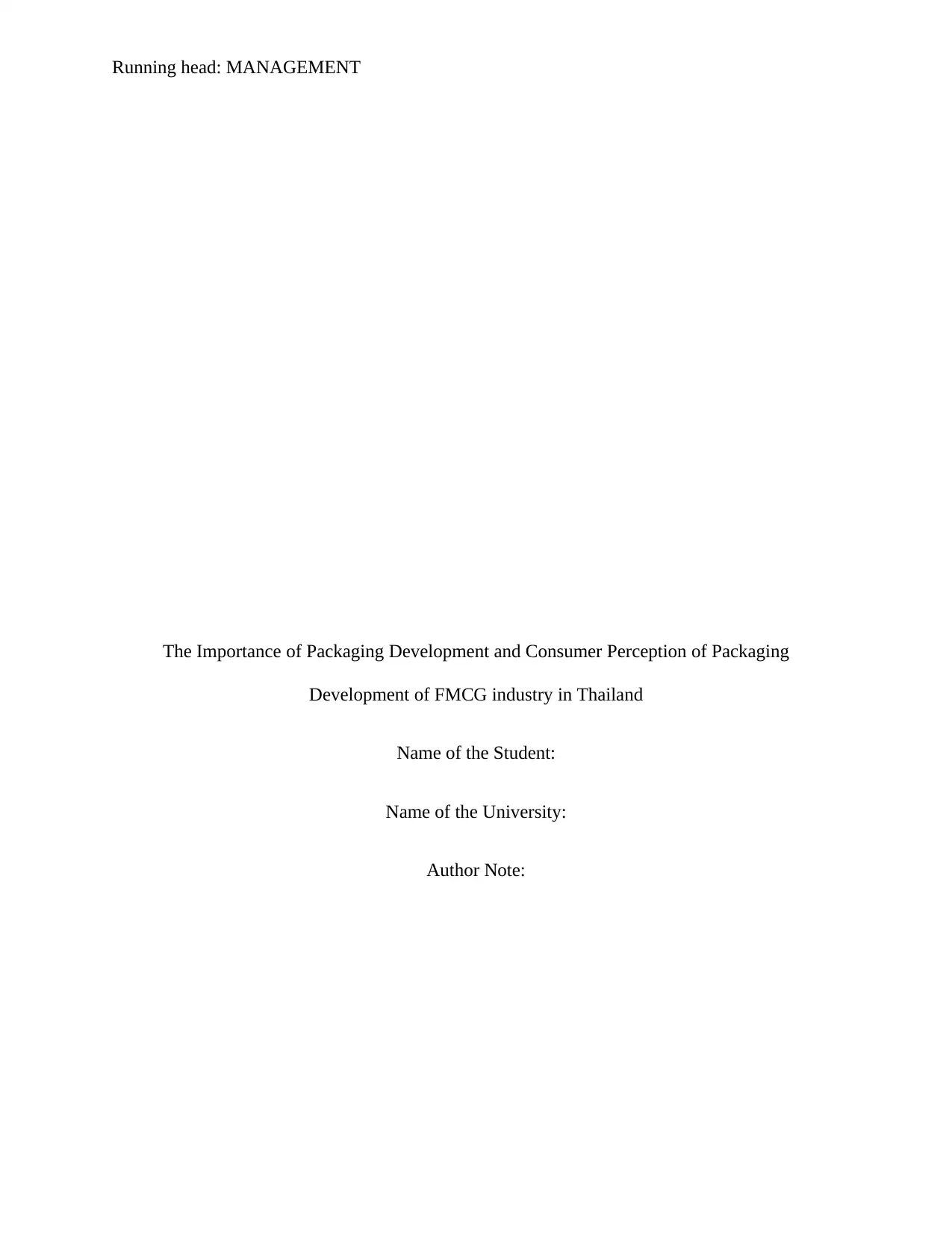
Running head: MANAGEMENT
The Importance of Packaging Development and Consumer Perception of Packaging
Development of FMCG industry in Thailand
Name of the Student:
Name of the University:
Author Note:
The Importance of Packaging Development and Consumer Perception of Packaging
Development of FMCG industry in Thailand
Name of the Student:
Name of the University:
Author Note:
Paraphrase This Document
Need a fresh take? Get an instant paraphrase of this document with our AI Paraphraser
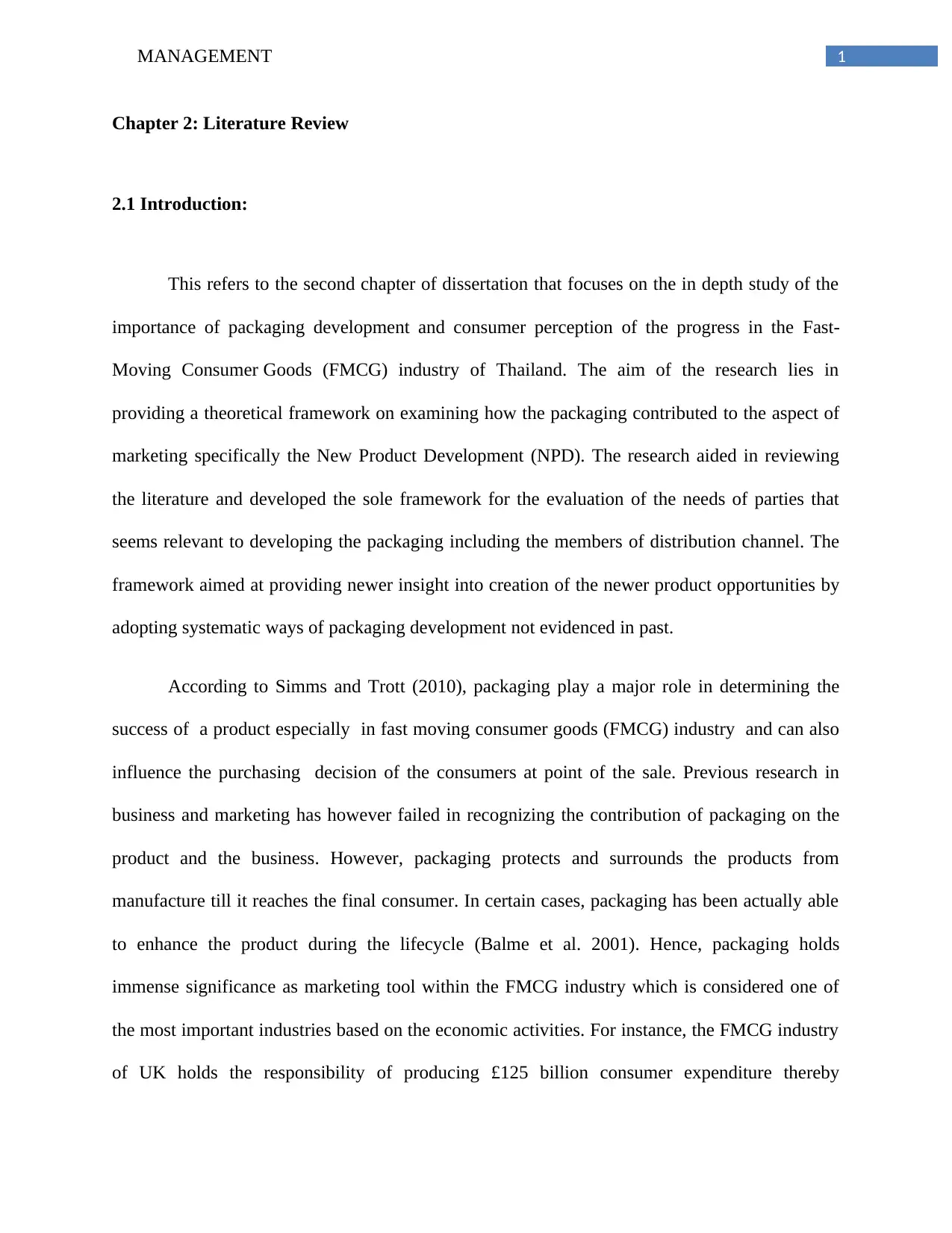
1MANAGEMENT
Chapter 2: Literature Review
2.1 Introduction:
This refers to the second chapter of dissertation that focuses on the in depth study of the
importance of packaging development and consumer perception of the progress in the Fast-
Moving Consumer Goods (FMCG) industry of Thailand. The aim of the research lies in
providing a theoretical framework on examining how the packaging contributed to the aspect of
marketing specifically the New Product Development (NPD). The research aided in reviewing
the literature and developed the sole framework for the evaluation of the needs of parties that
seems relevant to developing the packaging including the members of distribution channel. The
framework aimed at providing newer insight into creation of the newer product opportunities by
adopting systematic ways of packaging development not evidenced in past.
According to Simms and Trott (2010), packaging play a major role in determining the
success of a product especially in fast moving consumer goods (FMCG) industry and can also
influence the purchasing decision of the consumers at point of the sale. Previous research in
business and marketing has however failed in recognizing the contribution of packaging on the
product and the business. However, packaging protects and surrounds the products from
manufacture till it reaches the final consumer. In certain cases, packaging has been actually able
to enhance the product during the lifecycle (Balme et al. 2001). Hence, packaging holds
immense significance as marketing tool within the FMCG industry which is considered one of
the most important industries based on the economic activities. For instance, the FMCG industry
of UK holds the responsibility of producing £125 billion consumer expenditure thereby
Chapter 2: Literature Review
2.1 Introduction:
This refers to the second chapter of dissertation that focuses on the in depth study of the
importance of packaging development and consumer perception of the progress in the Fast-
Moving Consumer Goods (FMCG) industry of Thailand. The aim of the research lies in
providing a theoretical framework on examining how the packaging contributed to the aspect of
marketing specifically the New Product Development (NPD). The research aided in reviewing
the literature and developed the sole framework for the evaluation of the needs of parties that
seems relevant to developing the packaging including the members of distribution channel. The
framework aimed at providing newer insight into creation of the newer product opportunities by
adopting systematic ways of packaging development not evidenced in past.
According to Simms and Trott (2010), packaging play a major role in determining the
success of a product especially in fast moving consumer goods (FMCG) industry and can also
influence the purchasing decision of the consumers at point of the sale. Previous research in
business and marketing has however failed in recognizing the contribution of packaging on the
product and the business. However, packaging protects and surrounds the products from
manufacture till it reaches the final consumer. In certain cases, packaging has been actually able
to enhance the product during the lifecycle (Balme et al. 2001). Hence, packaging holds
immense significance as marketing tool within the FMCG industry which is considered one of
the most important industries based on the economic activities. For instance, the FMCG industry
of UK holds the responsibility of producing £125 billion consumer expenditure thereby
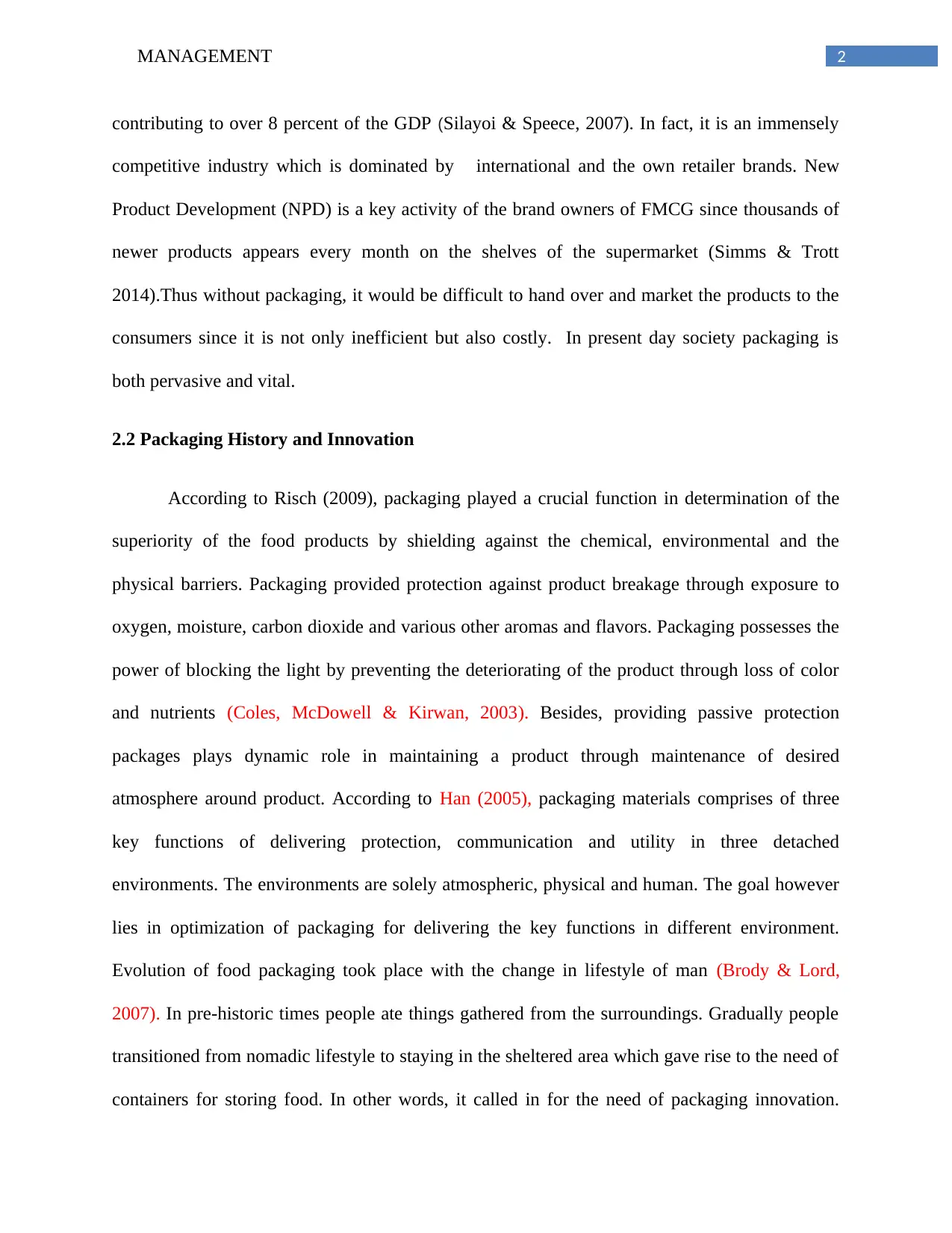
2MANAGEMENT
contributing to over 8 percent of the GDP (Silayoi & Speece, 2007). In fact, it is an immensely
competitive industry which is dominated by international and the own retailer brands. New
Product Development (NPD) is a key activity of the brand owners of FMCG since thousands of
newer products appears every month on the shelves of the supermarket (Simms & Trott
2014).Thus without packaging, it would be difficult to hand over and market the products to the
consumers since it is not only inefficient but also costly. In present day society packaging is
both pervasive and vital.
2.2 Packaging History and Innovation
According to Risch (2009), packaging played a crucial function in determination of the
superiority of the food products by shielding against the chemical, environmental and the
physical barriers. Packaging provided protection against product breakage through exposure to
oxygen, moisture, carbon dioxide and various other aromas and flavors. Packaging possesses the
power of blocking the light by preventing the deteriorating of the product through loss of color
and nutrients (Coles, McDowell & Kirwan, 2003). Besides, providing passive protection
packages plays dynamic role in maintaining a product through maintenance of desired
atmosphere around product. According to Han (2005), packaging materials comprises of three
key functions of delivering protection, communication and utility in three detached
environments. The environments are solely atmospheric, physical and human. The goal however
lies in optimization of packaging for delivering the key functions in different environment.
Evolution of food packaging took place with the change in lifestyle of man (Brody & Lord,
2007). In pre-historic times people ate things gathered from the surroundings. Gradually people
transitioned from nomadic lifestyle to staying in the sheltered area which gave rise to the need of
containers for storing food. In other words, it called in for the need of packaging innovation.
contributing to over 8 percent of the GDP (Silayoi & Speece, 2007). In fact, it is an immensely
competitive industry which is dominated by international and the own retailer brands. New
Product Development (NPD) is a key activity of the brand owners of FMCG since thousands of
newer products appears every month on the shelves of the supermarket (Simms & Trott
2014).Thus without packaging, it would be difficult to hand over and market the products to the
consumers since it is not only inefficient but also costly. In present day society packaging is
both pervasive and vital.
2.2 Packaging History and Innovation
According to Risch (2009), packaging played a crucial function in determination of the
superiority of the food products by shielding against the chemical, environmental and the
physical barriers. Packaging provided protection against product breakage through exposure to
oxygen, moisture, carbon dioxide and various other aromas and flavors. Packaging possesses the
power of blocking the light by preventing the deteriorating of the product through loss of color
and nutrients (Coles, McDowell & Kirwan, 2003). Besides, providing passive protection
packages plays dynamic role in maintaining a product through maintenance of desired
atmosphere around product. According to Han (2005), packaging materials comprises of three
key functions of delivering protection, communication and utility in three detached
environments. The environments are solely atmospheric, physical and human. The goal however
lies in optimization of packaging for delivering the key functions in different environment.
Evolution of food packaging took place with the change in lifestyle of man (Brody & Lord,
2007). In pre-historic times people ate things gathered from the surroundings. Gradually people
transitioned from nomadic lifestyle to staying in the sheltered area which gave rise to the need of
containers for storing food. In other words, it called in for the need of packaging innovation.
⊘ This is a preview!⊘
Do you want full access?
Subscribe today to unlock all pages.

Trusted by 1+ million students worldwide
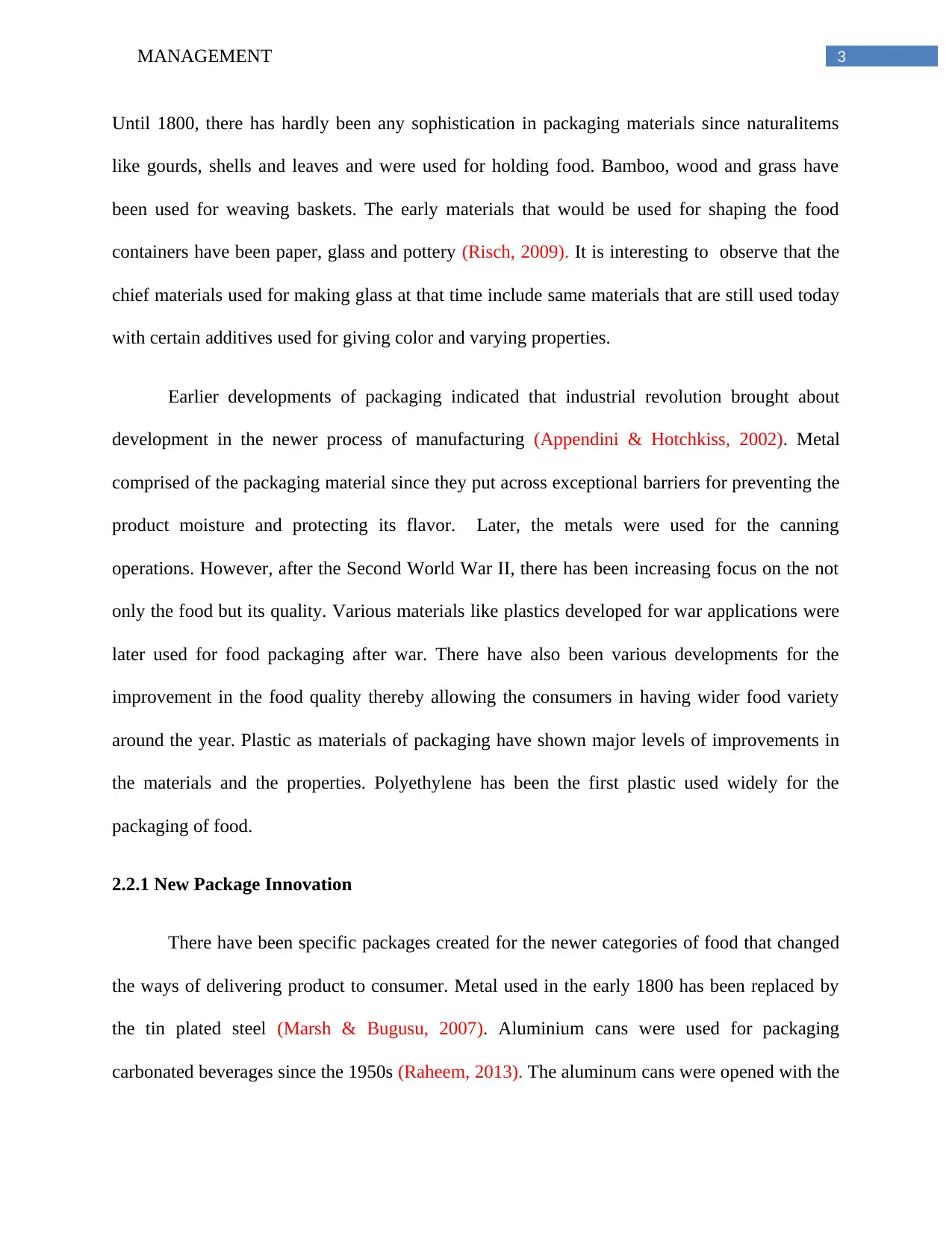
3MANAGEMENT
Until 1800, there has hardly been any sophistication in packaging materials since naturalitems
like gourds, shells and leaves and were used for holding food. Bamboo, wood and grass have
been used for weaving baskets. The early materials that would be used for shaping the food
containers have been paper, glass and pottery (Risch, 2009). It is interesting to observe that the
chief materials used for making glass at that time include same materials that are still used today
with certain additives used for giving color and varying properties.
Earlier developments of packaging indicated that industrial revolution brought about
development in the newer process of manufacturing (Appendini & Hotchkiss, 2002). Metal
comprised of the packaging material since they put across exceptional barriers for preventing the
product moisture and protecting its flavor. Later, the metals were used for the canning
operations. However, after the Second World War II, there has been increasing focus on the not
only the food but its quality. Various materials like plastics developed for war applications were
later used for food packaging after war. There have also been various developments for the
improvement in the food quality thereby allowing the consumers in having wider food variety
around the year. Plastic as materials of packaging have shown major levels of improvements in
the materials and the properties. Polyethylene has been the first plastic used widely for the
packaging of food.
2.2.1 New Package Innovation
There have been specific packages created for the newer categories of food that changed
the ways of delivering product to consumer. Metal used in the early 1800 has been replaced by
the tin plated steel (Marsh & Bugusu, 2007). Aluminium cans were used for packaging
carbonated beverages since the 1950s (Raheem, 2013). The aluminum cans were opened with the
Until 1800, there has hardly been any sophistication in packaging materials since naturalitems
like gourds, shells and leaves and were used for holding food. Bamboo, wood and grass have
been used for weaving baskets. The early materials that would be used for shaping the food
containers have been paper, glass and pottery (Risch, 2009). It is interesting to observe that the
chief materials used for making glass at that time include same materials that are still used today
with certain additives used for giving color and varying properties.
Earlier developments of packaging indicated that industrial revolution brought about
development in the newer process of manufacturing (Appendini & Hotchkiss, 2002). Metal
comprised of the packaging material since they put across exceptional barriers for preventing the
product moisture and protecting its flavor. Later, the metals were used for the canning
operations. However, after the Second World War II, there has been increasing focus on the not
only the food but its quality. Various materials like plastics developed for war applications were
later used for food packaging after war. There have also been various developments for the
improvement in the food quality thereby allowing the consumers in having wider food variety
around the year. Plastic as materials of packaging have shown major levels of improvements in
the materials and the properties. Polyethylene has been the first plastic used widely for the
packaging of food.
2.2.1 New Package Innovation
There have been specific packages created for the newer categories of food that changed
the ways of delivering product to consumer. Metal used in the early 1800 has been replaced by
the tin plated steel (Marsh & Bugusu, 2007). Aluminium cans were used for packaging
carbonated beverages since the 1950s (Raheem, 2013). The aluminum cans were opened with the
Paraphrase This Document
Need a fresh take? Get an instant paraphrase of this document with our AI Paraphraser
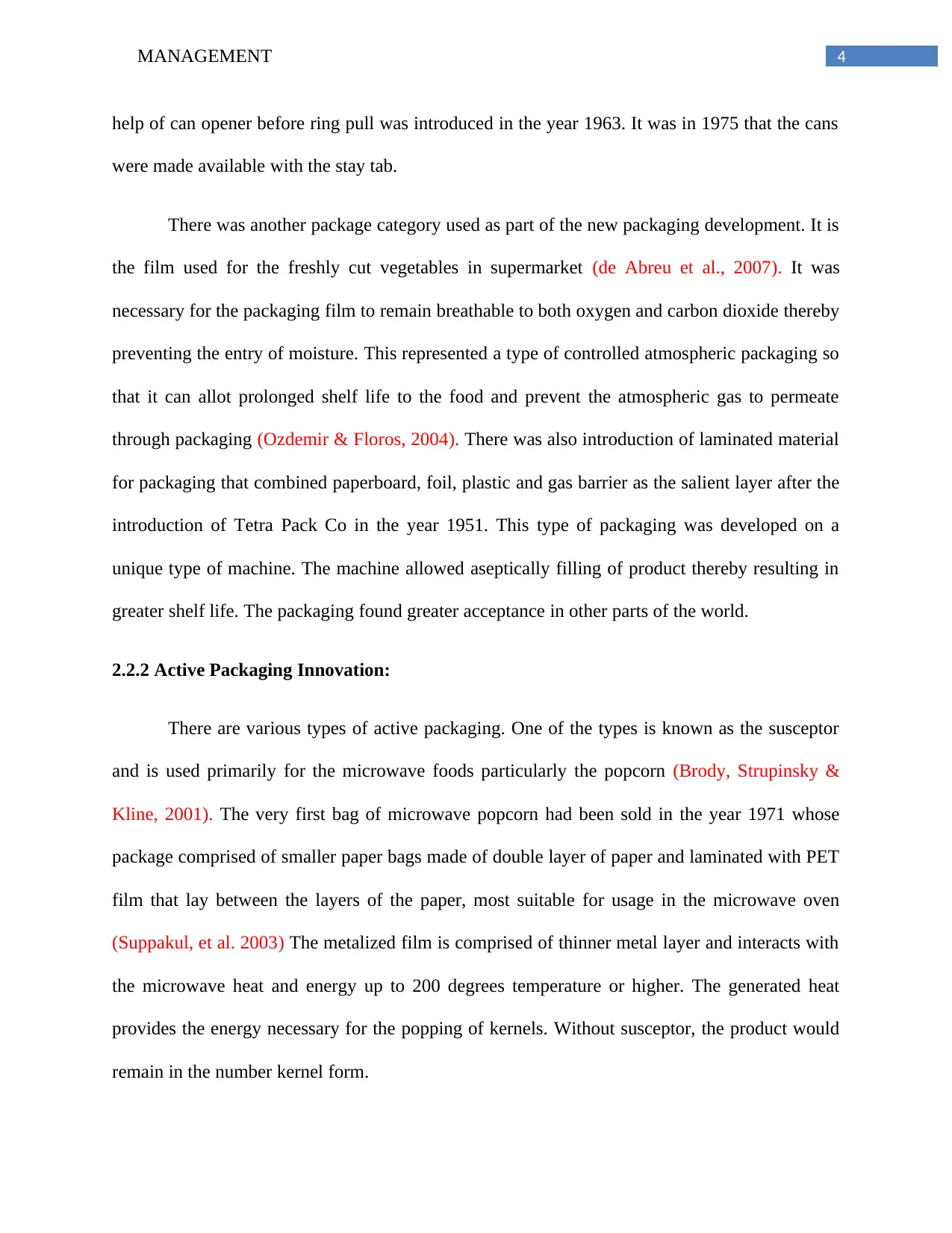
4MANAGEMENT
help of can opener before ring pull was introduced in the year 1963. It was in 1975 that the cans
were made available with the stay tab.
There was another package category used as part of the new packaging development. It is
the film used for the freshly cut vegetables in supermarket (de Abreu et al., 2007). It was
necessary for the packaging film to remain breathable to both oxygen and carbon dioxide thereby
preventing the entry of moisture. This represented a type of controlled atmospheric packaging so
that it can allot prolonged shelf life to the food and prevent the atmospheric gas to permeate
through packaging (Ozdemir & Floros, 2004). There was also introduction of laminated material
for packaging that combined paperboard, foil, plastic and gas barrier as the salient layer after the
introduction of Tetra Pack Co in the year 1951. This type of packaging was developed on a
unique type of machine. The machine allowed aseptically filling of product thereby resulting in
greater shelf life. The packaging found greater acceptance in other parts of the world.
2.2.2 Active Packaging Innovation:
There are various types of active packaging. One of the types is known as the susceptor
and is used primarily for the microwave foods particularly the popcorn (Brody, Strupinsky &
Kline, 2001). The very first bag of microwave popcorn had been sold in the year 1971 whose
package comprised of smaller paper bags made of double layer of paper and laminated with PET
film that lay between the layers of the paper, most suitable for usage in the microwave oven
(Suppakul, et al. 2003) The metalized film is comprised of thinner metal layer and interacts with
the microwave heat and energy up to 200 degrees temperature or higher. The generated heat
provides the energy necessary for the popping of kernels. Without susceptor, the product would
remain in the number kernel form.
help of can opener before ring pull was introduced in the year 1963. It was in 1975 that the cans
were made available with the stay tab.
There was another package category used as part of the new packaging development. It is
the film used for the freshly cut vegetables in supermarket (de Abreu et al., 2007). It was
necessary for the packaging film to remain breathable to both oxygen and carbon dioxide thereby
preventing the entry of moisture. This represented a type of controlled atmospheric packaging so
that it can allot prolonged shelf life to the food and prevent the atmospheric gas to permeate
through packaging (Ozdemir & Floros, 2004). There was also introduction of laminated material
for packaging that combined paperboard, foil, plastic and gas barrier as the salient layer after the
introduction of Tetra Pack Co in the year 1951. This type of packaging was developed on a
unique type of machine. The machine allowed aseptically filling of product thereby resulting in
greater shelf life. The packaging found greater acceptance in other parts of the world.
2.2.2 Active Packaging Innovation:
There are various types of active packaging. One of the types is known as the susceptor
and is used primarily for the microwave foods particularly the popcorn (Brody, Strupinsky &
Kline, 2001). The very first bag of microwave popcorn had been sold in the year 1971 whose
package comprised of smaller paper bags made of double layer of paper and laminated with PET
film that lay between the layers of the paper, most suitable for usage in the microwave oven
(Suppakul, et al. 2003) The metalized film is comprised of thinner metal layer and interacts with
the microwave heat and energy up to 200 degrees temperature or higher. The generated heat
provides the energy necessary for the popping of kernels. Without susceptor, the product would
remain in the number kernel form.
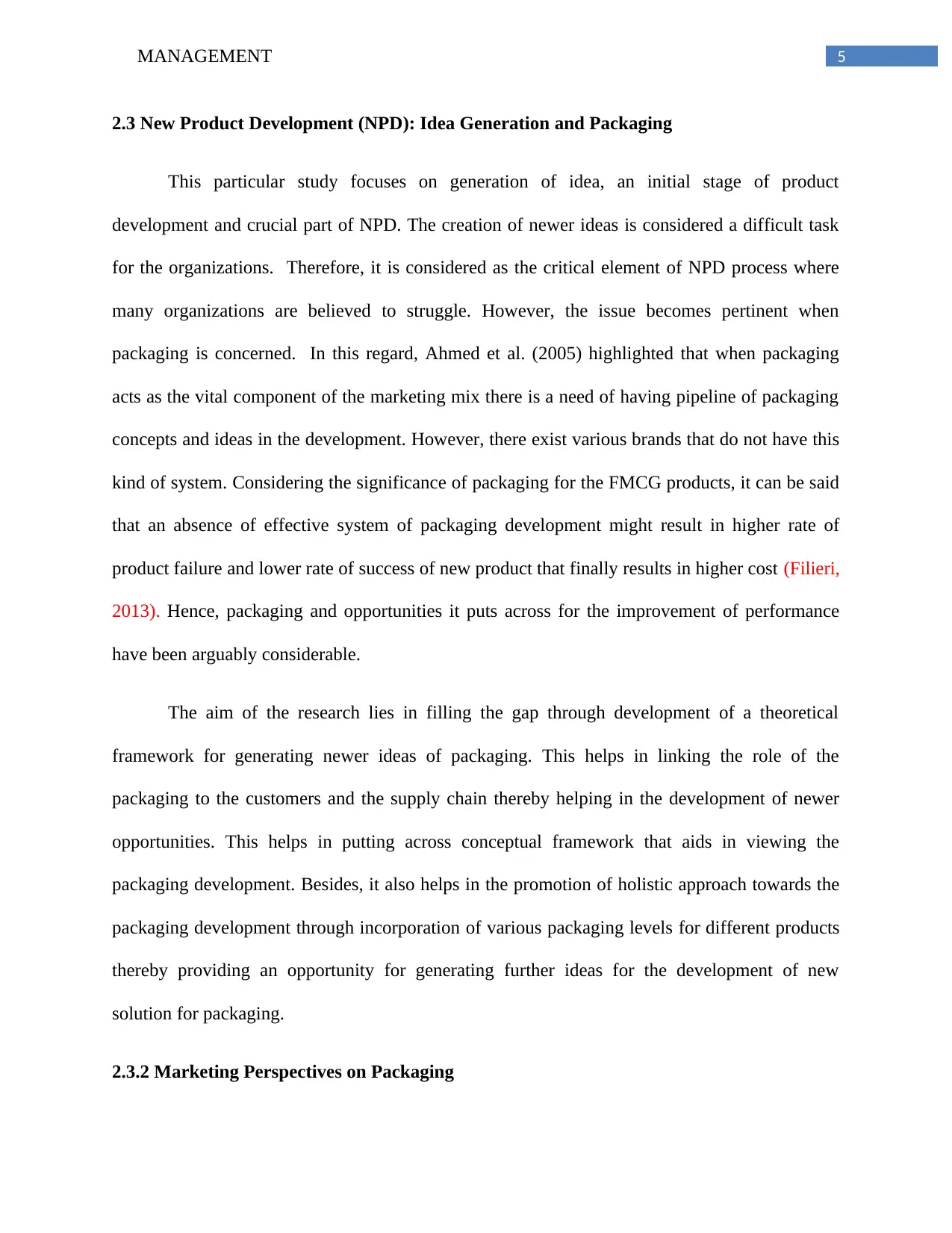
5MANAGEMENT
2.3 New Product Development (NPD): Idea Generation and Packaging
This particular study focuses on generation of idea, an initial stage of product
development and crucial part of NPD. The creation of newer ideas is considered a difficult task
for the organizations. Therefore, it is considered as the critical element of NPD process where
many organizations are believed to struggle. However, the issue becomes pertinent when
packaging is concerned. In this regard, Ahmed et al. (2005) highlighted that when packaging
acts as the vital component of the marketing mix there is a need of having pipeline of packaging
concepts and ideas in the development. However, there exist various brands that do not have this
kind of system. Considering the significance of packaging for the FMCG products, it can be said
that an absence of effective system of packaging development might result in higher rate of
product failure and lower rate of success of new product that finally results in higher cost (Filieri,
2013). Hence, packaging and opportunities it puts across for the improvement of performance
have been arguably considerable.
The aim of the research lies in filling the gap through development of a theoretical
framework for generating newer ideas of packaging. This helps in linking the role of the
packaging to the customers and the supply chain thereby helping in the development of newer
opportunities. This helps in putting across conceptual framework that aids in viewing the
packaging development. Besides, it also helps in the promotion of holistic approach towards the
packaging development through incorporation of various packaging levels for different products
thereby providing an opportunity for generating further ideas for the development of new
solution for packaging.
2.3.2 Marketing Perspectives on Packaging
2.3 New Product Development (NPD): Idea Generation and Packaging
This particular study focuses on generation of idea, an initial stage of product
development and crucial part of NPD. The creation of newer ideas is considered a difficult task
for the organizations. Therefore, it is considered as the critical element of NPD process where
many organizations are believed to struggle. However, the issue becomes pertinent when
packaging is concerned. In this regard, Ahmed et al. (2005) highlighted that when packaging
acts as the vital component of the marketing mix there is a need of having pipeline of packaging
concepts and ideas in the development. However, there exist various brands that do not have this
kind of system. Considering the significance of packaging for the FMCG products, it can be said
that an absence of effective system of packaging development might result in higher rate of
product failure and lower rate of success of new product that finally results in higher cost (Filieri,
2013). Hence, packaging and opportunities it puts across for the improvement of performance
have been arguably considerable.
The aim of the research lies in filling the gap through development of a theoretical
framework for generating newer ideas of packaging. This helps in linking the role of the
packaging to the customers and the supply chain thereby helping in the development of newer
opportunities. This helps in putting across conceptual framework that aids in viewing the
packaging development. Besides, it also helps in the promotion of holistic approach towards the
packaging development through incorporation of various packaging levels for different products
thereby providing an opportunity for generating further ideas for the development of new
solution for packaging.
2.3.2 Marketing Perspectives on Packaging
⊘ This is a preview!⊘
Do you want full access?
Subscribe today to unlock all pages.

Trusted by 1+ million students worldwide
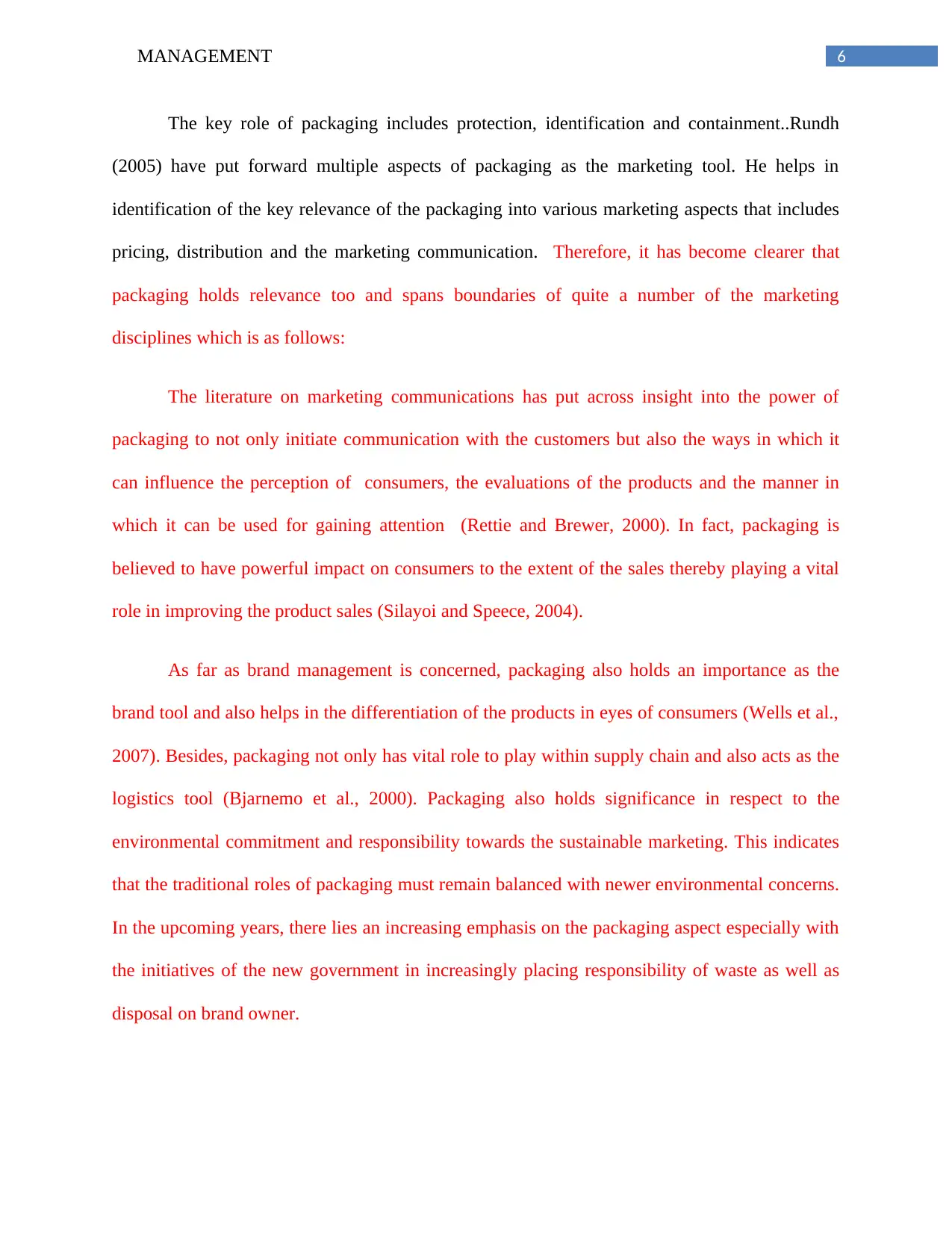
6MANAGEMENT
The key role of packaging includes protection, identification and containment..Rundh
(2005) have put forward multiple aspects of packaging as the marketing tool. He helps in
identification of the key relevance of the packaging into various marketing aspects that includes
pricing, distribution and the marketing communication. Therefore, it has become clearer that
packaging holds relevance too and spans boundaries of quite a number of the marketing
disciplines which is as follows:
The literature on marketing communications has put across insight into the power of
packaging to not only initiate communication with the customers but also the ways in which it
can influence the perception of consumers, the evaluations of the products and the manner in
which it can be used for gaining attention (Rettie and Brewer, 2000). In fact, packaging is
believed to have powerful impact on consumers to the extent of the sales thereby playing a vital
role in improving the product sales (Silayoi and Speece, 2004).
As far as brand management is concerned, packaging also holds an importance as the
brand tool and also helps in the differentiation of the products in eyes of consumers (Wells et al.,
2007). Besides, packaging not only has vital role to play within supply chain and also acts as the
logistics tool (Bjarnemo et al., 2000). Packaging also holds significance in respect to the
environmental commitment and responsibility towards the sustainable marketing. This indicates
that the traditional roles of packaging must remain balanced with newer environmental concerns.
In the upcoming years, there lies an increasing emphasis on the packaging aspect especially with
the initiatives of the new government in increasingly placing responsibility of waste as well as
disposal on brand owner.
The key role of packaging includes protection, identification and containment..Rundh
(2005) have put forward multiple aspects of packaging as the marketing tool. He helps in
identification of the key relevance of the packaging into various marketing aspects that includes
pricing, distribution and the marketing communication. Therefore, it has become clearer that
packaging holds relevance too and spans boundaries of quite a number of the marketing
disciplines which is as follows:
The literature on marketing communications has put across insight into the power of
packaging to not only initiate communication with the customers but also the ways in which it
can influence the perception of consumers, the evaluations of the products and the manner in
which it can be used for gaining attention (Rettie and Brewer, 2000). In fact, packaging is
believed to have powerful impact on consumers to the extent of the sales thereby playing a vital
role in improving the product sales (Silayoi and Speece, 2004).
As far as brand management is concerned, packaging also holds an importance as the
brand tool and also helps in the differentiation of the products in eyes of consumers (Wells et al.,
2007). Besides, packaging not only has vital role to play within supply chain and also acts as the
logistics tool (Bjarnemo et al., 2000). Packaging also holds significance in respect to the
environmental commitment and responsibility towards the sustainable marketing. This indicates
that the traditional roles of packaging must remain balanced with newer environmental concerns.
In the upcoming years, there lies an increasing emphasis on the packaging aspect especially with
the initiatives of the new government in increasingly placing responsibility of waste as well as
disposal on brand owner.
Paraphrase This Document
Need a fresh take? Get an instant paraphrase of this document with our AI Paraphraser
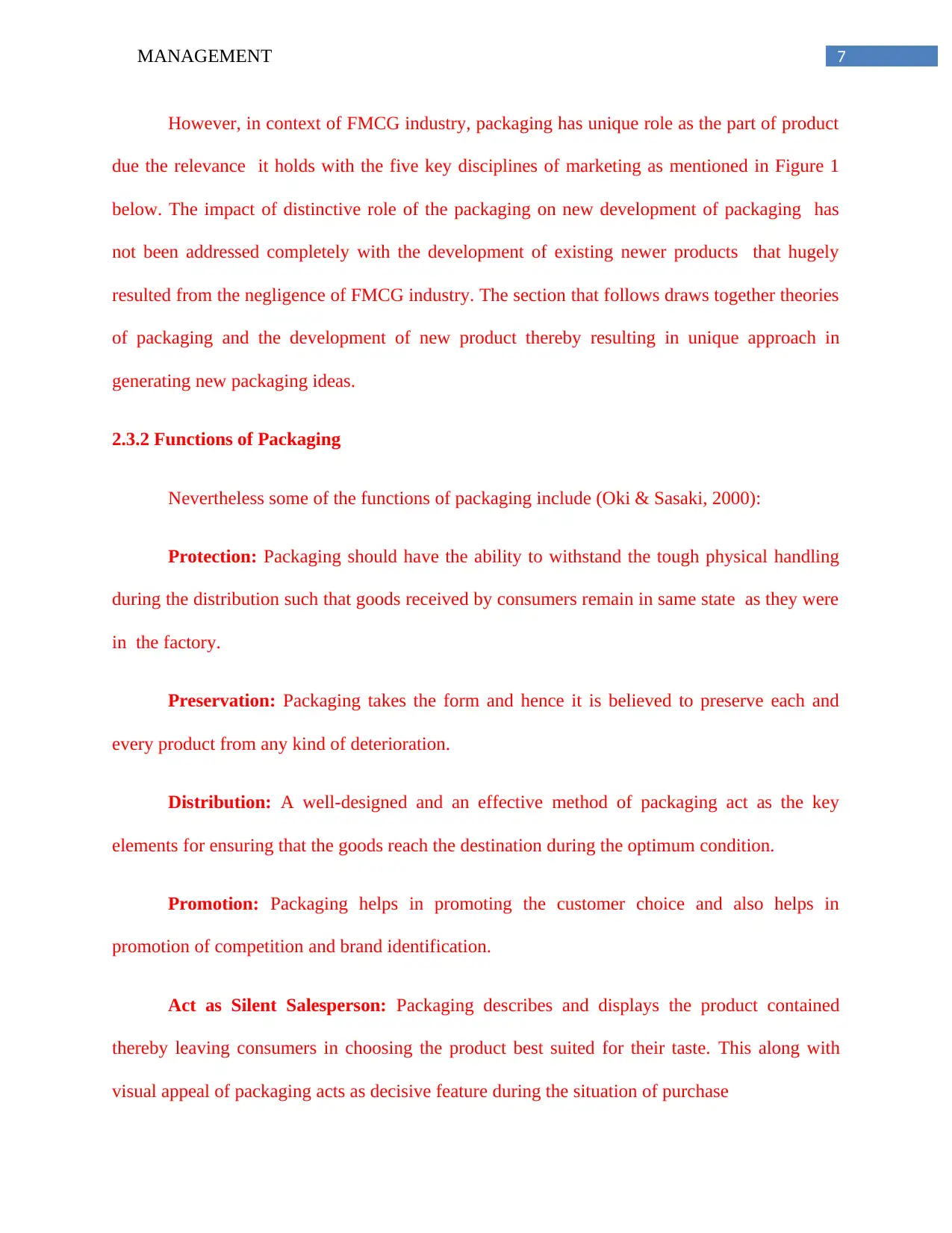
7MANAGEMENT
However, in context of FMCG industry, packaging has unique role as the part of product
due the relevance it holds with the five key disciplines of marketing as mentioned in Figure 1
below. The impact of distinctive role of the packaging on new development of packaging has
not been addressed completely with the development of existing newer products that hugely
resulted from the negligence of FMCG industry. The section that follows draws together theories
of packaging and the development of new product thereby resulting in unique approach in
generating new packaging ideas.
2.3.2 Functions of Packaging
Nevertheless some of the functions of packaging include (Oki & Sasaki, 2000):
Protection: Packaging should have the ability to withstand the tough physical handling
during the distribution such that goods received by consumers remain in same state as they were
in the factory.
Preservation: Packaging takes the form and hence it is believed to preserve each and
every product from any kind of deterioration.
Distribution: A well-designed and an effective method of packaging act as the key
elements for ensuring that the goods reach the destination during the optimum condition.
Promotion: Packaging helps in promoting the customer choice and also helps in
promotion of competition and brand identification.
Act as Silent Salesperson: Packaging describes and displays the product contained
thereby leaving consumers in choosing the product best suited for their taste. This along with
visual appeal of packaging acts as decisive feature during the situation of purchase
However, in context of FMCG industry, packaging has unique role as the part of product
due the relevance it holds with the five key disciplines of marketing as mentioned in Figure 1
below. The impact of distinctive role of the packaging on new development of packaging has
not been addressed completely with the development of existing newer products that hugely
resulted from the negligence of FMCG industry. The section that follows draws together theories
of packaging and the development of new product thereby resulting in unique approach in
generating new packaging ideas.
2.3.2 Functions of Packaging
Nevertheless some of the functions of packaging include (Oki & Sasaki, 2000):
Protection: Packaging should have the ability to withstand the tough physical handling
during the distribution such that goods received by consumers remain in same state as they were
in the factory.
Preservation: Packaging takes the form and hence it is believed to preserve each and
every product from any kind of deterioration.
Distribution: A well-designed and an effective method of packaging act as the key
elements for ensuring that the goods reach the destination during the optimum condition.
Promotion: Packaging helps in promoting the customer choice and also helps in
promotion of competition and brand identification.
Act as Silent Salesperson: Packaging describes and displays the product contained
thereby leaving consumers in choosing the product best suited for their taste. This along with
visual appeal of packaging acts as decisive feature during the situation of purchase
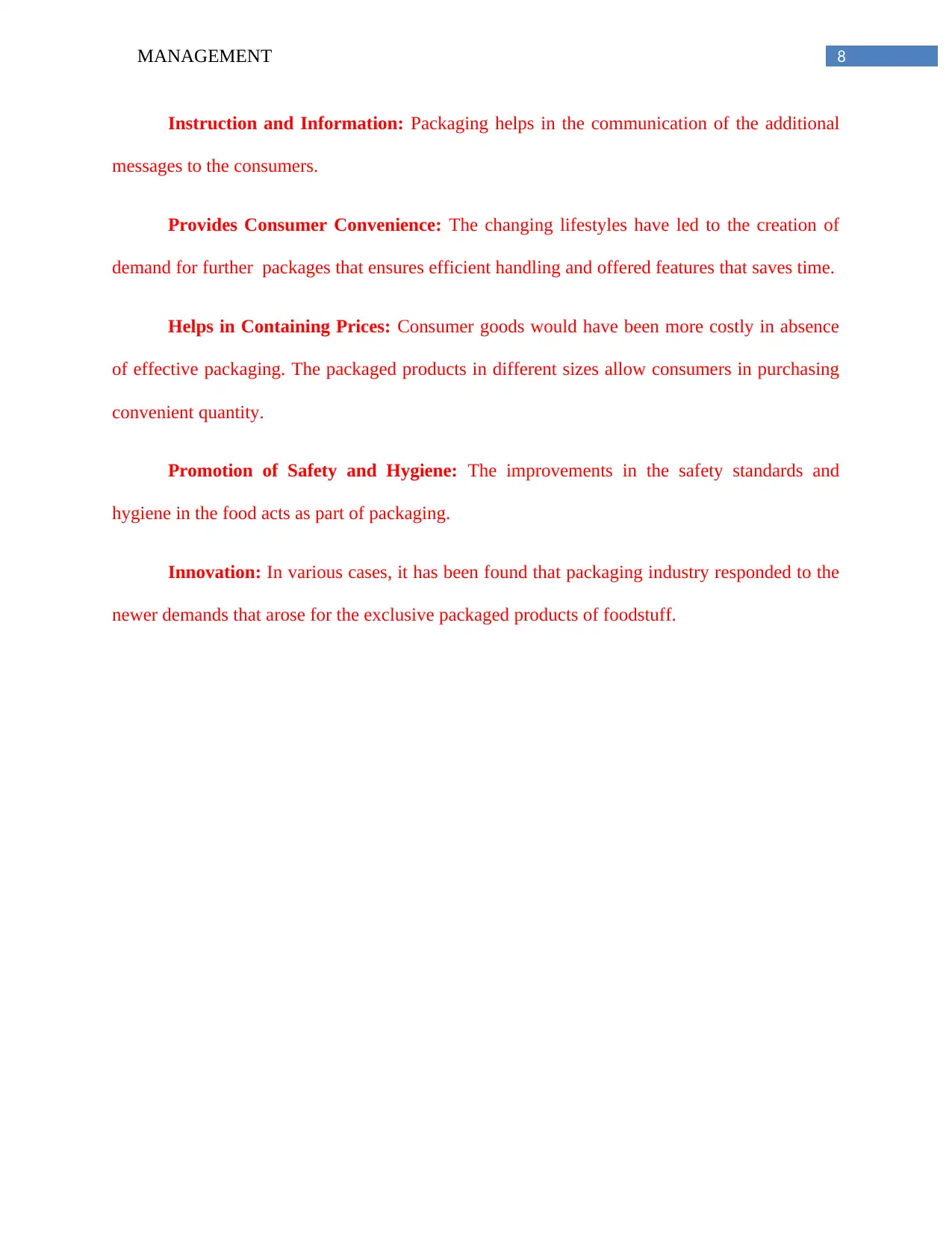
8MANAGEMENT
Instruction and Information: Packaging helps in the communication of the additional
messages to the consumers.
Provides Consumer Convenience: The changing lifestyles have led to the creation of
demand for further packages that ensures efficient handling and offered features that saves time.
Helps in Containing Prices: Consumer goods would have been more costly in absence
of effective packaging. The packaged products in different sizes allow consumers in purchasing
convenient quantity.
Promotion of Safety and Hygiene: The improvements in the safety standards and
hygiene in the food acts as part of packaging.
Innovation: In various cases, it has been found that packaging industry responded to the
newer demands that arose for the exclusive packaged products of foodstuff.
Instruction and Information: Packaging helps in the communication of the additional
messages to the consumers.
Provides Consumer Convenience: The changing lifestyles have led to the creation of
demand for further packages that ensures efficient handling and offered features that saves time.
Helps in Containing Prices: Consumer goods would have been more costly in absence
of effective packaging. The packaged products in different sizes allow consumers in purchasing
convenient quantity.
Promotion of Safety and Hygiene: The improvements in the safety standards and
hygiene in the food acts as part of packaging.
Innovation: In various cases, it has been found that packaging industry responded to the
newer demands that arose for the exclusive packaged products of foodstuff.
⊘ This is a preview!⊘
Do you want full access?
Subscribe today to unlock all pages.

Trusted by 1+ million students worldwide
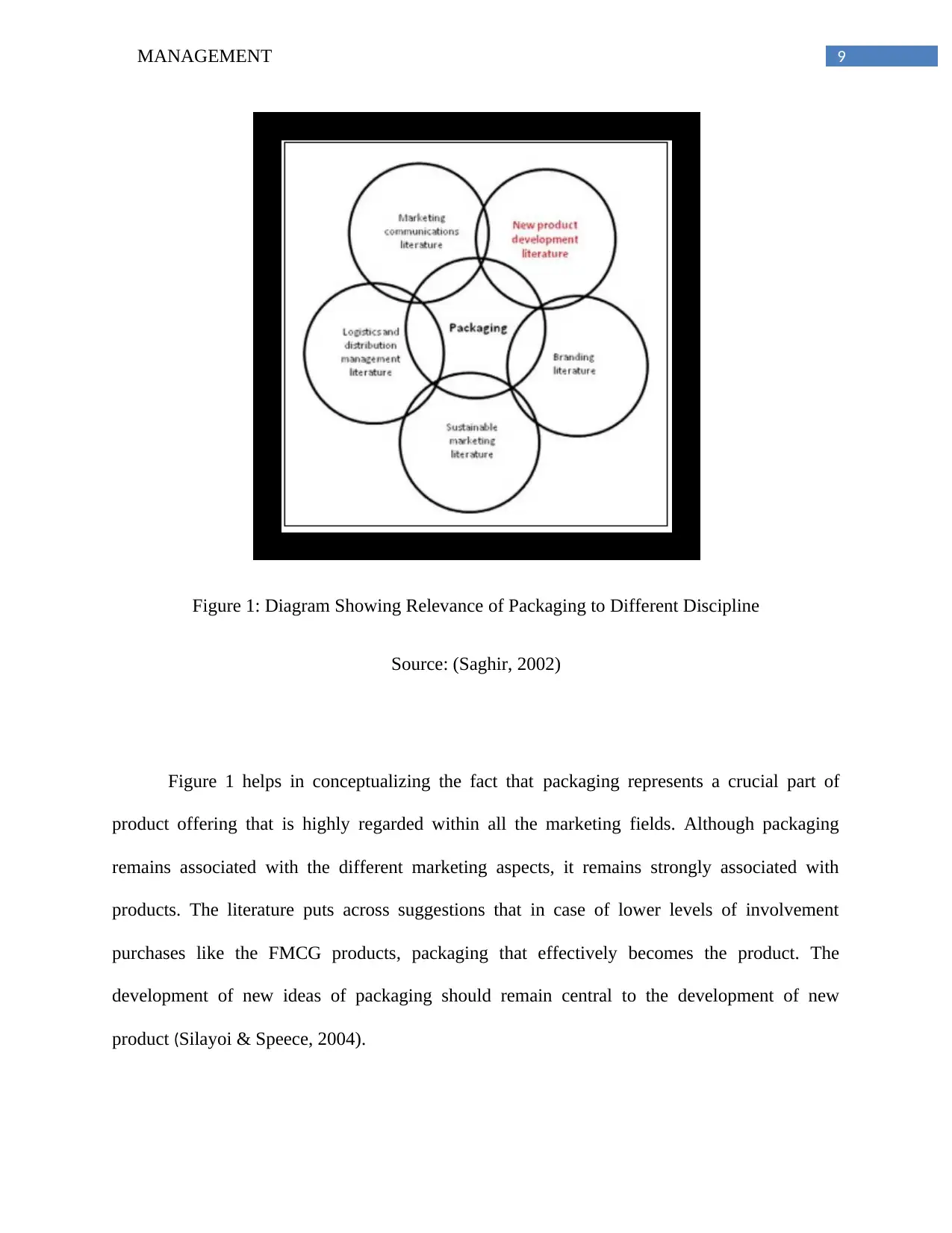
9MANAGEMENT
Figure 1: Diagram Showing Relevance of Packaging to Different Discipline
Source: (Saghir, 2002)
Figure 1 helps in conceptualizing the fact that packaging represents a crucial part of
product offering that is highly regarded within all the marketing fields. Although packaging
remains associated with the different marketing aspects, it remains strongly associated with
products. The literature puts across suggestions that in case of lower levels of involvement
purchases like the FMCG products, packaging that effectively becomes the product. The
development of new ideas of packaging should remain central to the development of new
product (Silayoi & Speece, 2004).
Figure 1: Diagram Showing Relevance of Packaging to Different Discipline
Source: (Saghir, 2002)
Figure 1 helps in conceptualizing the fact that packaging represents a crucial part of
product offering that is highly regarded within all the marketing fields. Although packaging
remains associated with the different marketing aspects, it remains strongly associated with
products. The literature puts across suggestions that in case of lower levels of involvement
purchases like the FMCG products, packaging that effectively becomes the product. The
development of new ideas of packaging should remain central to the development of new
product (Silayoi & Speece, 2004).
Paraphrase This Document
Need a fresh take? Get an instant paraphrase of this document with our AI Paraphraser
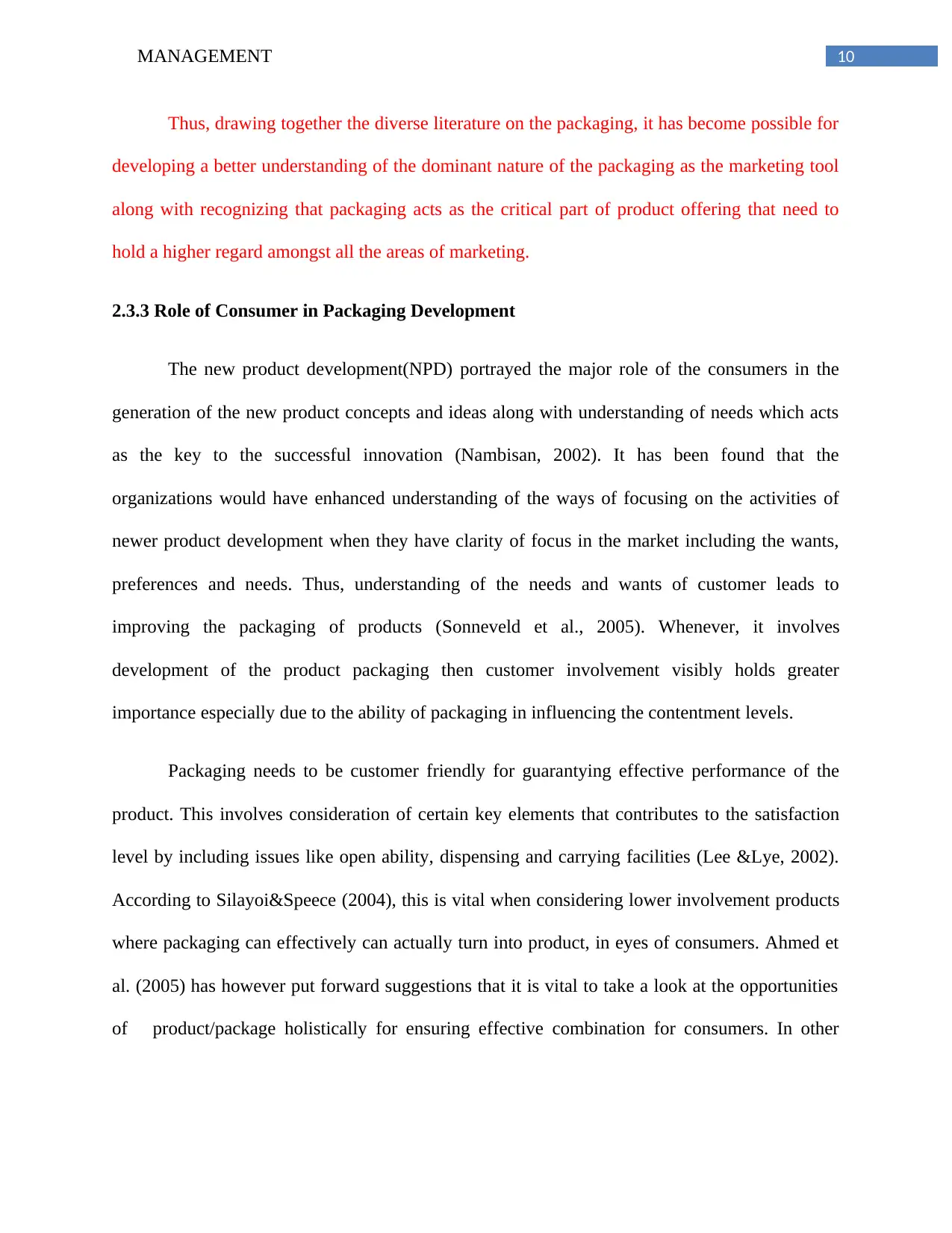
10MANAGEMENT
Thus, drawing together the diverse literature on the packaging, it has become possible for
developing a better understanding of the dominant nature of the packaging as the marketing tool
along with recognizing that packaging acts as the critical part of product offering that need to
hold a higher regard amongst all the areas of marketing.
2.3.3 Role of Consumer in Packaging Development
The new product development(NPD) portrayed the major role of the consumers in the
generation of the new product concepts and ideas along with understanding of needs which acts
as the key to the successful innovation (Nambisan, 2002). It has been found that the
organizations would have enhanced understanding of the ways of focusing on the activities of
newer product development when they have clarity of focus in the market including the wants,
preferences and needs. Thus, understanding of the needs and wants of customer leads to
improving the packaging of products (Sonneveld et al., 2005). Whenever, it involves
development of the product packaging then customer involvement visibly holds greater
importance especially due to the ability of packaging in influencing the contentment levels.
Packaging needs to be customer friendly for guarantying effective performance of the
product. This involves consideration of certain key elements that contributes to the satisfaction
level by including issues like open ability, dispensing and carrying facilities (Lee &Lye, 2002).
According to Silayoi&Speece (2004), this is vital when considering lower involvement products
where packaging can effectively can actually turn into product, in eyes of consumers. Ahmed et
al. (2005) has however put forward suggestions that it is vital to take a look at the opportunities
of product/package holistically for ensuring effective combination for consumers. In other
Thus, drawing together the diverse literature on the packaging, it has become possible for
developing a better understanding of the dominant nature of the packaging as the marketing tool
along with recognizing that packaging acts as the critical part of product offering that need to
hold a higher regard amongst all the areas of marketing.
2.3.3 Role of Consumer in Packaging Development
The new product development(NPD) portrayed the major role of the consumers in the
generation of the new product concepts and ideas along with understanding of needs which acts
as the key to the successful innovation (Nambisan, 2002). It has been found that the
organizations would have enhanced understanding of the ways of focusing on the activities of
newer product development when they have clarity of focus in the market including the wants,
preferences and needs. Thus, understanding of the needs and wants of customer leads to
improving the packaging of products (Sonneveld et al., 2005). Whenever, it involves
development of the product packaging then customer involvement visibly holds greater
importance especially due to the ability of packaging in influencing the contentment levels.
Packaging needs to be customer friendly for guarantying effective performance of the
product. This involves consideration of certain key elements that contributes to the satisfaction
level by including issues like open ability, dispensing and carrying facilities (Lee &Lye, 2002).
According to Silayoi&Speece (2004), this is vital when considering lower involvement products
where packaging can effectively can actually turn into product, in eyes of consumers. Ahmed et
al. (2005) has however put forward suggestions that it is vital to take a look at the opportunities
of product/package holistically for ensuring effective combination for consumers. In other
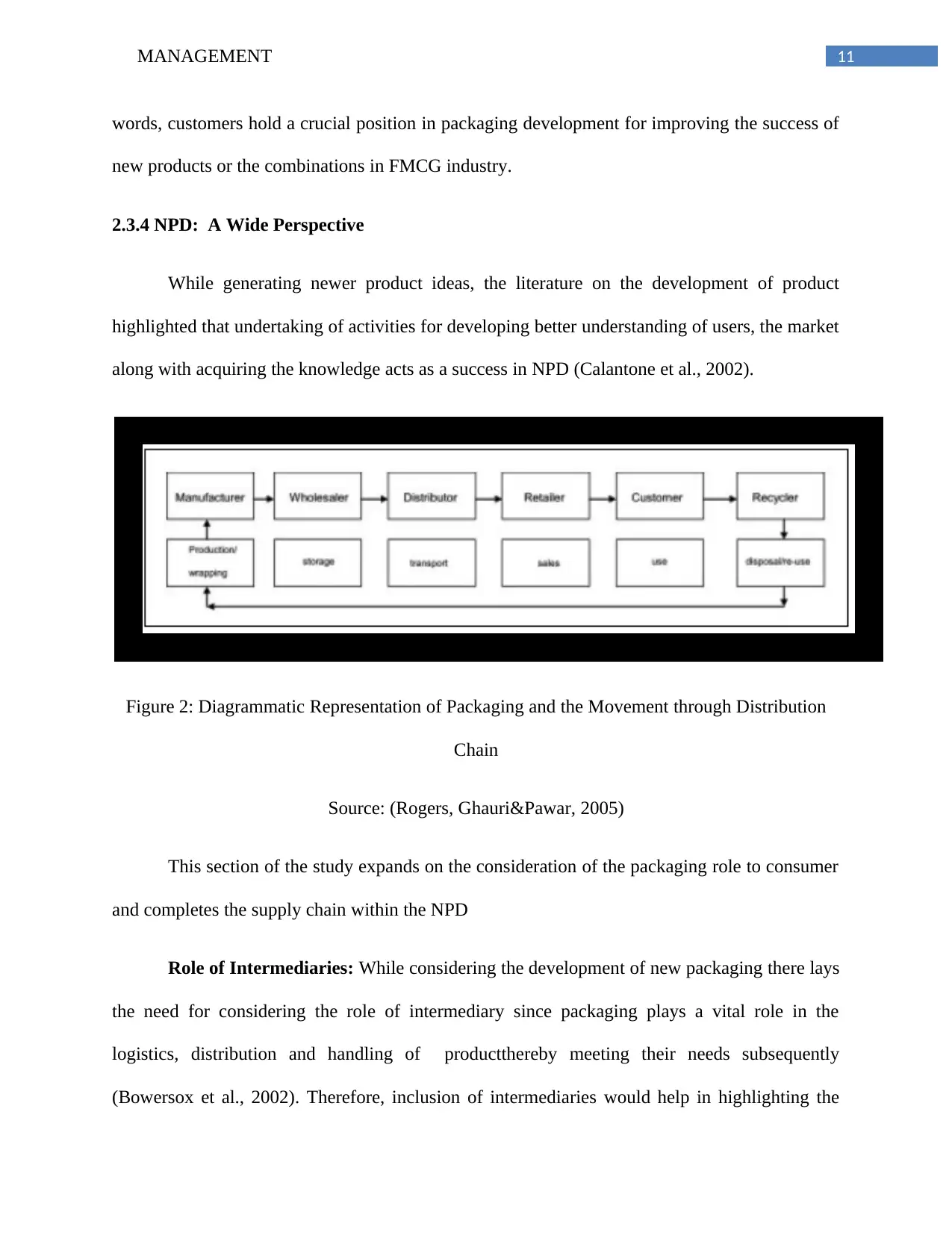
11MANAGEMENT
words, customers hold a crucial position in packaging development for improving the success of
new products or the combinations in FMCG industry.
2.3.4 NPD: A Wide Perspective
While generating newer product ideas, the literature on the development of product
highlighted that undertaking of activities for developing better understanding of users, the market
along with acquiring the knowledge acts as a success in NPD (Calantone et al., 2002).
Figure 2: Diagrammatic Representation of Packaging and the Movement through Distribution
Chain
Source: (Rogers, Ghauri&Pawar, 2005)
This section of the study expands on the consideration of the packaging role to consumer
and completes the supply chain within the NPD
Role of Intermediaries: While considering the development of new packaging there lays
the need for considering the role of intermediary since packaging plays a vital role in the
logistics, distribution and handling of productthereby meeting their needs subsequently
(Bowersox et al., 2002). Therefore, inclusion of intermediaries would help in highlighting the
words, customers hold a crucial position in packaging development for improving the success of
new products or the combinations in FMCG industry.
2.3.4 NPD: A Wide Perspective
While generating newer product ideas, the literature on the development of product
highlighted that undertaking of activities for developing better understanding of users, the market
along with acquiring the knowledge acts as a success in NPD (Calantone et al., 2002).
Figure 2: Diagrammatic Representation of Packaging and the Movement through Distribution
Chain
Source: (Rogers, Ghauri&Pawar, 2005)
This section of the study expands on the consideration of the packaging role to consumer
and completes the supply chain within the NPD
Role of Intermediaries: While considering the development of new packaging there lays
the need for considering the role of intermediary since packaging plays a vital role in the
logistics, distribution and handling of productthereby meeting their needs subsequently
(Bowersox et al., 2002). Therefore, inclusion of intermediaries would help in highlighting the
⊘ This is a preview!⊘
Do you want full access?
Subscribe today to unlock all pages.

Trusted by 1+ million students worldwide
1 out of 26
Your All-in-One AI-Powered Toolkit for Academic Success.
+13062052269
info@desklib.com
Available 24*7 on WhatsApp / Email
![[object Object]](/_next/static/media/star-bottom.7253800d.svg)
Unlock your academic potential
Copyright © 2020–2025 A2Z Services. All Rights Reserved. Developed and managed by ZUCOL.


